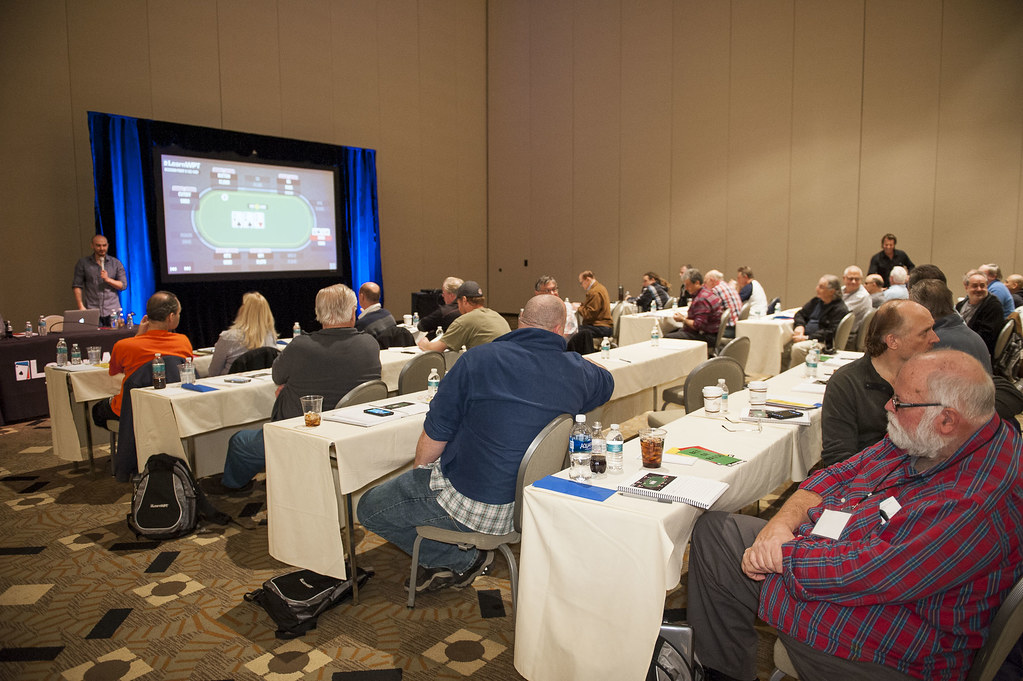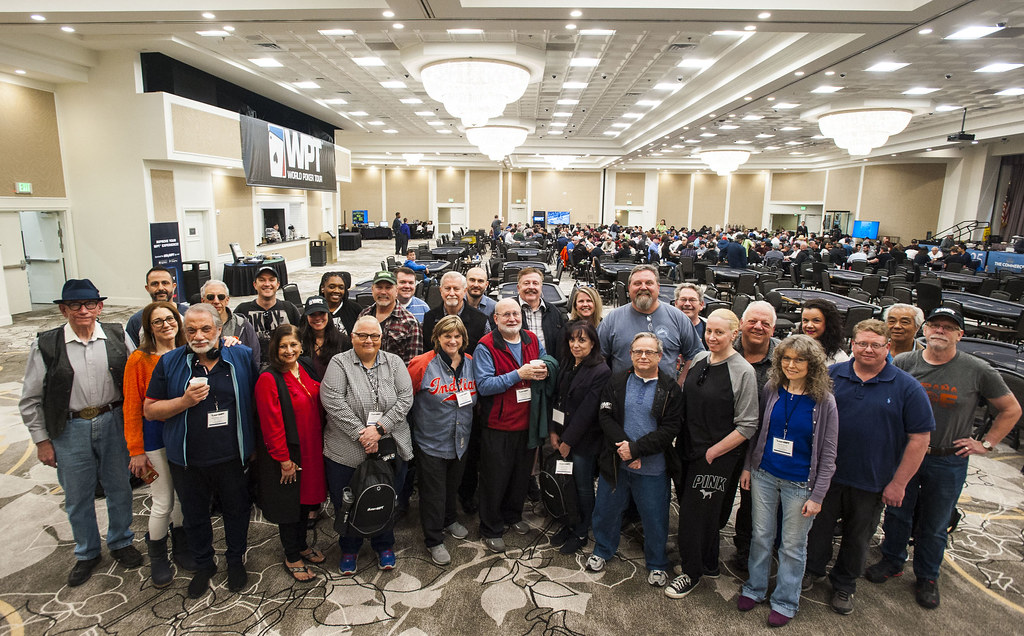Nick Binger and Eric Lynch Have a Particular Strategy When They Teach Poker Strategy at LearnWPT Workshops
Feb 26, 2018

LearnWPT hosted a workshop during the two recent days at the WPT L.A. Poker Classic at Commerce Casino, which included a number of classroom workshop sessions for the 30 students in attendance, plus a special live tournament that awarded a number of prizes. The winner took home a $3,500 seat to any WPT event at that buy-in level hosted in 2018, the runner-up got a seat in an upcoming LearnWPT workshop (the next one will take place May 26-27 at the ARIA Resort & Casino in Las Vegas), third place was a year’s membership on LearnWPT, and fourth place received a special WPT chip set. In addition to those prizes, the top four players in the tournament also took home a deck of cards from Faded Spade, the preferred playing cards of the WPT.
We caught up with Nick Binger (pictured above at far left at a previous LearnWPT workshop) and Eric Lynch during the LearnWPT tournament to talk about the strategy deployed when teaching the LearnWPT students how to take their game to the next level.
“One of the things we try to do at LearnWPT is have more of a system that people can follow so that we can essentially give people good ground rules for various situations so they know what to do in those situations,” Binger said when he was asked about his guiding philosophy in teaching LearnWPT workshops. “Then they can build from there and add in nuance and deviation over time, rather than trying to teach people basically that they can do anything at any time.”
Of course, poker is a game full of incomplete information. Players who succeed over the long term are the ones who can best complete the puzzle without having all the pieces, much like guessing the word or phrase on Wheel of Fortune without having all the letters plugged in. With LearnWPT, Binger says, the objective is to provide the best foundation possible that will allow LearnWPT students to make high-quality decisions that set up them for success.
“We give them clear ground rules to start, and then teach them how to deviate in appropriate spots,” Binger said. “We give people a clear way to approach the game and to improve their decision-making process so that they’re able to go into various scenarios, play in different games or tournament levels, and be able to have a way to approach no-limit hold’em rather than a little bit of everything, which is the way a lot of people teach.”
Lynch agreed with Binger’s sentiments, and then he had the following to add regarding the approach.
“The decision trees and everything that we put in front of people to tell them the questions to ask themselves to make good decisions, that’s one thing I haven’t seen in a whole lot of other places,” Lynch said. “We definitely put an emphasis on teaching people how to think through those processes and decisions so they can come to the right conclusions. Not only like Nick said, like knowing how to make moves or playing too tight, when you can take the emotion out of it and really think analytically, that’s super important. I think having those processes to fall back on, those questions to ask yourself, is super important in being able to do that.”
By diving into the basics of poker strategy with their students, Binger and Lynch give LearnWPT players the tools they need to not get overwhelmed by the almost limitless number of decisions they will need to make on the felt. This helps them see the forest for the trees.

At this current LearnWPT session, LearnWPT emphasized key strategic lessons with its students directed at tournament poker before letting the students put that new knowledge to use.
“One of the big things with this particular workshop, which is a tournament strategy workshop, is diving into the when and why to making moves,” Binger said. “Going through all the different types of moves that a player can make, but also the factors to look for that should be in place to make those moves. There are times in tournaments where you’re supposed to play aggressively; you’re supposed to make a move almost regardless of your hand. At those times, it’s important to identify those factors so that you’re able to pull the trigger when they come up in a tournament.”
In poker, what Binger is referring to is often the tight-passive approach many players revert to playing. If you’re following poker, especially tournament poker, you know one of the most impressive characteristics of top professional players is the ability to go for it when they need to, to crank up the aggressive level regardless of their hole cards.
“Most people, especially most amateur players or intermediate players, they end up playing too tight in tournaments,” Binger said. “They end up waiting for good things to happen. If your strategy in a tournament is to just wait for good things to happen to you, you’re probably going to end up blinding down. We give people the tools to accumulate chips even when they’re not getting good cards.”
Binger and Lynch are also big advocates of letting the students take a hands-on approach to developing their poker strategy. It’s easy to teach to a textbook, but LearnWPT students truly improve their game when they have to use the ideas learned in the workshops in real poker situations. LearnWPT does this by running decision-making scenarios in its workshops and then letting the students use those lessons in a live tournament at the end of the workshop that runs alongside one of the marquee events on the WPT schedule.
“We have a theory that we talk about in the classroom setting, and then we put them to real decisions, and we do that by having real scenarios on screen and we force the students to make decisions,” Binger said of the approach. “Then they can analyze what type of decision they made versus the decisions we made. Then we move on and now they’re actually playing, so it’s a step-by-step process to take theory into practice. Because it’s one thing to listen in a classroom and say, ‘OK, that makes sense.’ It’s something else to actually be able to apply it at the table. I think that is something that we do pretty well. We distill a lot of teaching down to something that is really applicable and functional for people at the table. I think a lot of instruction out there is kind of all over the place, and some of it is pretty high level, and it doesn’t really walk people all the way through.”
Lynch and Binger also both admitted that teaching LearnWPT sessions has improved their poker games as well. When you spend multiple days actively talking about, teaching, and thinking about poker, it can only benefit the teacher as well as the student.
“Absolutely,” Lynch said when asked if he receives benefit from the courses and workshops he puts out. “Having to take the things that you do at the table and articulate them to other people just reinforces it more in your mind. I actually find that a lot of times my best results are after I teach one of these workshops. I will go home and I will just be revved up because I’ve just been talking poker with a bunch of enthusiastic people. I go sit at the tables and I will have some of my best sessions. It’s super sexy to talk about cold four-bet bluffing and things like that, but most of the things that make you money at the poker table are just executing the basics consistently and well. When I teach one of these, they’re just hammered home.”

If you’re interested in attending one of the LearnWPT workshops or want to sign up for a LearnWPT membership, check out LearnWPT.com, where you can get started with two free strategy videos.

 @WPT
@WPT